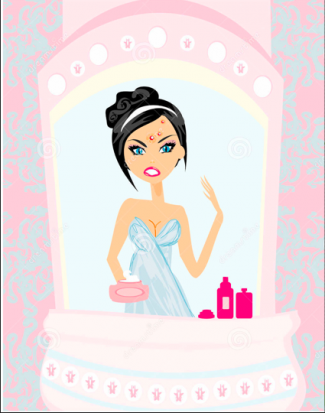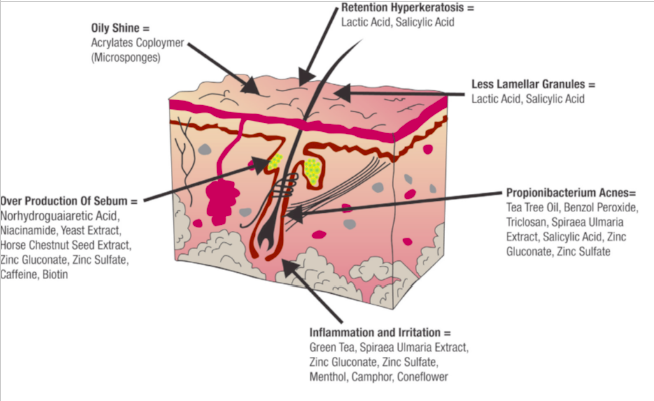A common misconception is that acne only affects teenagers. But more than ever before, adults are suffering with oily and acneic skin conditions.
Clinical studies indicate that between 40 and 55 percent of the adult population in the 20-40 age group are diagnosed with a low grade, persistent acne and oily skin. According to the Journal of American Academy of Dermatology, 54% of women older than age 25 have some facial acne, which is most likely attributed to hormonal fluctuations that trigger excess sebum (oil) resulting in acne.
Acne arising in adulthood is more likely to be inflammatory, with fewer comedones (blackheads) than teenage acne, and with lesions predominantly located around the mouth, chin and jaw line. Likewise, adults often have sensitized skin, or a combination of skin conditions in addition to their acne, which makes treatment more challenging than treatment of teens that generally have a more resilient, uniform oily skin condition.
In addition, adult cases of acne are often more persistent than teenage acne, which can be particularly frustrating for those who were spared breakouts as teenagers.
Specific to teens
- Acne is now becoming more prevalent in children 7-12 years old.
- Acne affects 80% of people 11 to 30 years old.
- It is the most common complaint by teens.
- By mid-teens, more than 40% of adolescents have acne or acne scarring.
- Breakouts appear mainly on the cheeks and forehead but can appear on chest and back as well.
What are the four main biochemical triggers that contribute to acne (adult or teen)?
The primary catalyst of adult acne is chronic stress. Balancing personal and professional responsibilities makes this generation of adults the most time-compressed generation in history. Chronic stress: the constant, continued and heightened level of stress that throws our adrenal glands into overdrive, which in turn can boost sebum production, setting the stage for acne development.
In teens it is predominantly the hormones during puberty that triggers Acne. While stress or hormones creates the trigger for acne, there are four main factors that contribute to the development of acne: overactive sebaceous glands (the production of too much oil), dead skin cell accumulation, bacteria and inflammation.
Images showing Acne development
1: Overactive Sebaceous (oil) Glands
Despite which form of acne is prevalent, it is known that sebum production or oil is the catalyst for the series of events that result in acne or breakouts. Often times, a client will not think they have even a mild form of acne and will attribute their skin condition to excess oiliness. As skin care professionals, we know that this excess sebum is often associated with enlarged pores, a tendency toward follicle (pore) congestion and an oily T-zone in adults, whereas oiliness is all over the face in teens.
2 & 3: Cell Accumulation and Bacteria
In a normal follicle (Image A), dead surface cells are continually sloughed from the epidermal canal and are deposited at the surface of the skin. However, when acne is present, a proliferation of cells occurs at the neck of the follicle, accompanied by excess sebum that causes the cells to stick together along with bacteria (usually Propionibacterium acnes, which is also known as Corynebacterium acnes); the conglomeration of the sebum and cells leads to formation of an impaction plug that provides a nice anaerobic environment for the bacteria to thrive in. This process, whereby abnormal desquamation of sebaceous-follicle epithelium results in altered keratinization, is often called retention hyperkeratosis (holding onto too many dead skin cells).
This first stage impacted follicle is often referred to as a micro-comedone. Researchers have found that there are fewer lamellar granules in the Stratum Granulosum of acneic skin. As the lamellar granules contain the desquamation enzymes and lipids that comprise the barrier layer in the intercellular spaces, this could account for the accumulation of cells in the follicle canal. Likewise, acneic skin is more permeable around the sebaceous gland and follicle, which may lead to leakage and inflammation into surrounding tissues. Studies have shown that Linoleic Acid, an essential fatty acid that is a component of the barrier lipid layer, is indeed deficient in acneic clients.
The bacteria in the follicle excrete a lipase enzyme to break down the sebum triglycerides into fatty acids and glycerol. The sebum is used as a food source and the free fatty acids are merely waste products that irritate the lining of the follicle. At this point, the disease may result in non-inflammatory lesions and simply produce closed comedones (whiteheads – Image B) which may turn into open comedones (blackheads – Image C) and expel their contents.
4: Inflammation
Inflamed lesions may also result, whereby the follicle wall ruptures forming a papule (Image D). If the break in the follicle is close to the surface, a pustule results (Image E). If it is deeper, a nodule forms. In some cases, a membrane entraps the infection and a cyst develops. Regardless, Matrix Metalloproteinase (MMPs) enzymes are stimulated to help repair the damaged tissue and white blood cells invade the area: this is when inflammation sets in.
Main triggers of Acne in teens and adults
- Hormones
- Drugs
- Stress
- Cosmetic products
- Heat
- Friction
- Humidity
- Environmental pollutants
What can be done to help treat, clear and prevent Acne?
In order to control acne, we must interrupt the degeneration of the follicle by affecting the four main contributing factors. The International Dermal Institute has researched several new ingredients that are extremely effective in controlling acne. We can classify these ingredients according to the problem that each specifically addresses. By inhibiting the activity of overactive sebaceous glands, we not only eliminate the food source for the bacteria, but we also eliminate oily shine and create a more aesthetically-pleasing appearance for the client. The following ingredients are known sebum-regulating agents: Nordihydroguaiaretic Acid, Niacinamide, Yeast Extract, Aesculus Hippocastanum (Horse Chestnut) Extract, Acrylates Copolymer (microsponges), Sarcosine and Zinc Gluconate.
To control cell accumulation we need to stimulate natural exfoliation superficially as well as in the follicle lining. By exfoliating to remove surface cells that have not been shed, we can help eliminate the impaction of follicles which triggers the early stages of comedone formation.
The following are known exfoliating agents: Salicylic Acid, Lactic Acid, Sulfur and Papain. By controlling bacteria on the skin’s surface and in the follicle, and the lipase activity, we can control the source of fatty acids that contribute to irritation.
The following ingredients are known anti-bacterial agents: Benzoyl Peroxide, Spiraea Ulmaria Extract, Cinnamomum Zeylamium Bark Extract, Salicylic Acid, Melaleuca Alternifolia (Tea Tree) Oil, Zinc Gluconate, Zinc Sulfate, Melissa Officinalis (Balm Mint) Extract, Rosmarinus Officinalis (Rosemary) Extract, Sulfur and Sarcosine.
To help keep inflammation caused by adult acne under control, we must consider the application of topical anti-inflammatory repair agents, botanicals and humectants to help the healing process and soothe inflamed skin. The following are known anti-inflammatory and reparative agents: Camellia Sinensis (Green Tea), Panthenol, Camphor, Bisabolol, Allantoin, Echinacea Purpurea (Coneflower), Oat Extract and Glycyrrhiza Glabra (Licorice) Extract.
Dermalogica’s MediBac Clearing® system works to treat, clear and prevent adult acne while addressing the needs of adult skin. The MediBac Clearing® system controls acne without compromising skin’s integrity, which means skin is consistently clear and healthier. Each product, with its unique acne-fighting and clearing ingredients, is designed to be layered upon the skin to provide around-the-clock, maximum control of the four main factors that contribute to acne. ”
Dermalogica’s Clear Start range is a skin care line for teens and young adults developed to both prevent and treat symptoms of mild to moderate acne. The line consists of nine products. The products are sold individually as well as in a convenient kit form. It addresses the specific needs of teen and young adult skin. It utilises proven blemish-fighting ingredients and soothing botanicals to reduce bacteria, control oil, and clear breakouts.
Jane Wurwand, Founder and Chief Visionary for Dermalogica and Clear Start, comments, “Body and psyche are always intertwined, and this crossover feels especially intense during adolescence in particular. Acne’s scars are deeply felt on the soul as well as on the skin, so we developed Clear Start to intercept acne before the symptoms escalate, and also to teach young adults, teens and even younger teens healthy skin care habits.
Information supplied by @dermalogicasa
 a
a









You must be logged in to post a comment.
You must log in to post a comment.